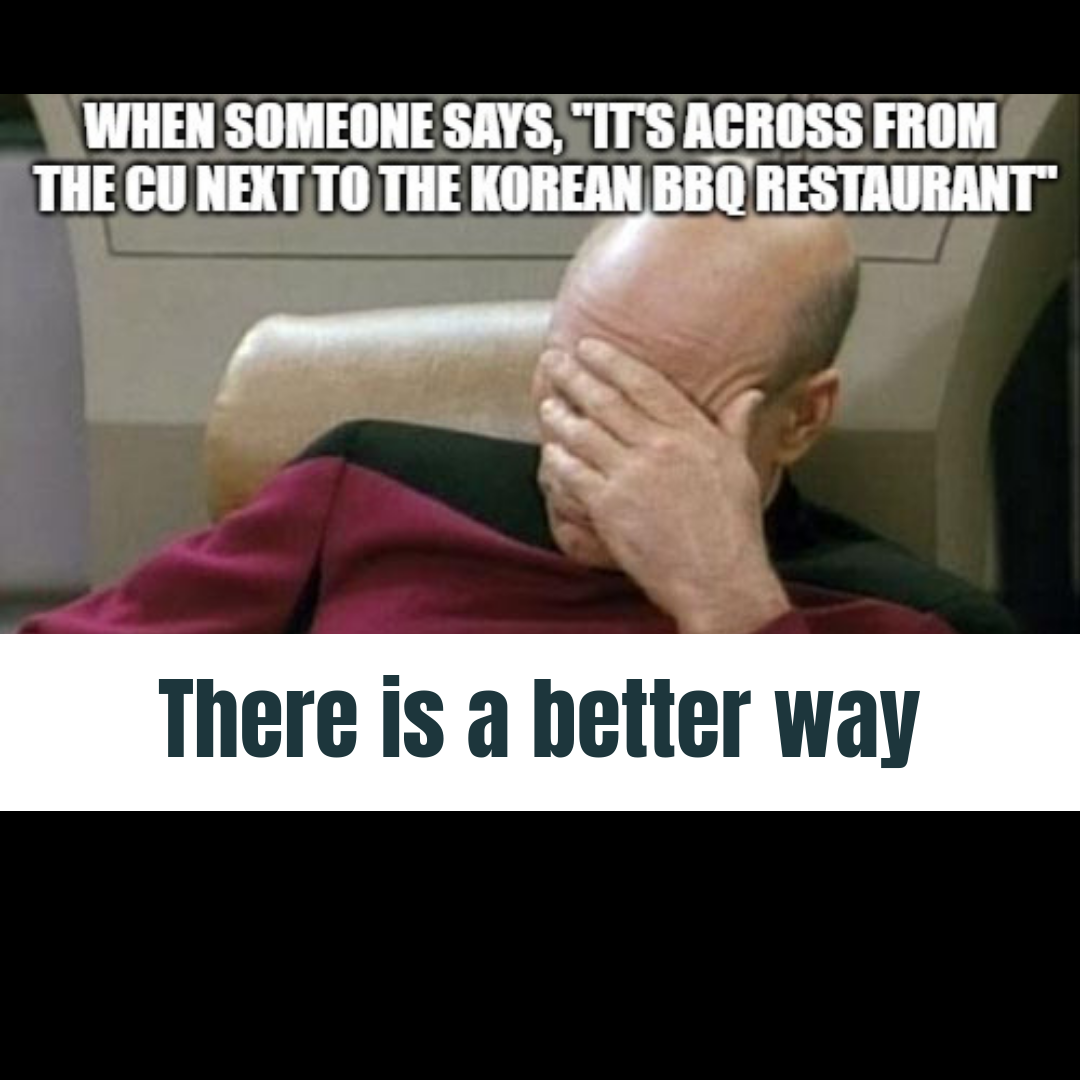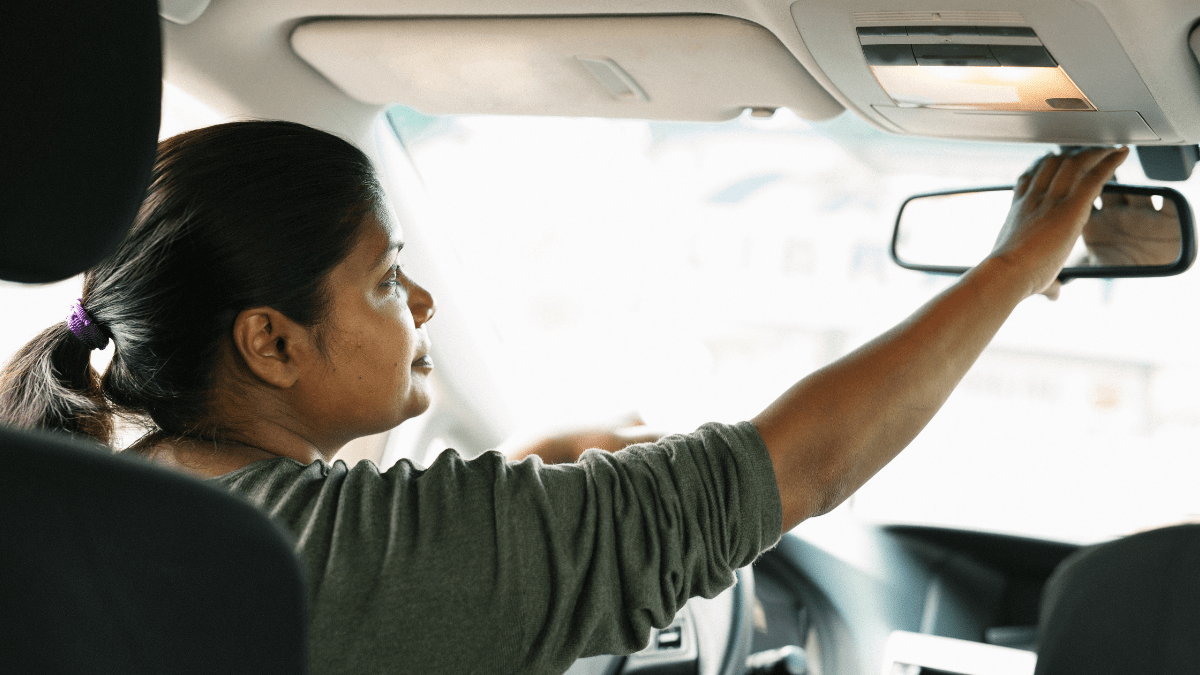
Getting Your Korean Driver’s License from Scratch
Hello, I am an English educator from the United States living in rural South Korea. Recently, I went through the testing process for my South Korean driver’s license at the Yongin Driving Center. I thought it might be helpful to share my story. I can only speak from my experience here, some testing sites might differ.
Let’s go….
About Getting Your Korean Driver’s’ License as a US Citizen
Since Driver’s Licenses in the United States are issued by state, each state has its own reciprocity agreement with South Korea regarding the exchange for driver’s licenses. That means, as of 2022 14 states have agreements for exchanging licenses:
- Alabama
- Florida
- Idaho
- Iowa
- Maryland
- Massachusetts
- Michigan
- Oregon
- Texas
- Virginia
- Washington
- West Virginia
- Colorado
- Georgia
In order to exchange a driver’s license from one of these states, one must have the license apostilled in the state of origin. Such complications may mean that US educators who wish to live and drive in South Korea may choose to get a South Korean driver’s license through testing. This was the route I chose to take.
Solo Driver’s Licence Exam v. Driver’s Licence Hagwon
Once I decided to test for my Korean driver’s license I needed to choose between taking the exams independently or going through a driving hagwon. Driving hagwons cost around 1.5 million won prepare you for the exam. Some driving hagwons even offer classes in English.
Since I am comfortable driving and have done so for many years, I choose to take the exams through a driver’s license testing center. Such centers do not require hagwon classes and I could simply take a series of tests to earn my license. Such a process was less expensive and less time-consuming.
Driving Hagwon with English Speaking Instructors
If you decided you would like to earn your license through a driving hagwon, here is an option. In Pyeongtaek, there is a popular driving hagwon with English instructors in Paengseong. A number of other English educators in South Korea have used this location. It may take 1-2 weeks to get your license through a driving hagwon depending on your schedule and theirs.
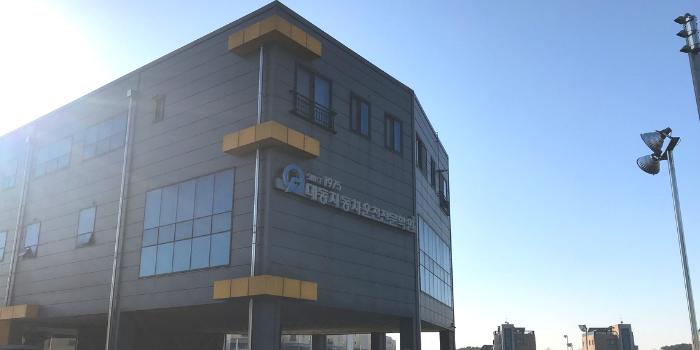
Driving School
031-655-5252
Copy and paste phone numbers into Naver Maps to get directions
Description:
If you need to get your license in Korea you can either take the test in Yongin or you can go through driving school. This is a great option if you are nervous about Korean rules or having had a license before. The cost will usually be between 1,200 - 1,800 depending on what test you are studying for. At this location they will teach you in English. Local English teachers, who speak no Korean, have used them and were very satisfied with the experience.
Hangul Address:
경기도 평택시 팽성읍 안정순환로 21
Hangul Name:
대동자동차운전전문학원
That said, I did not choose the hagwon route and this is how it went…
My Testing Location
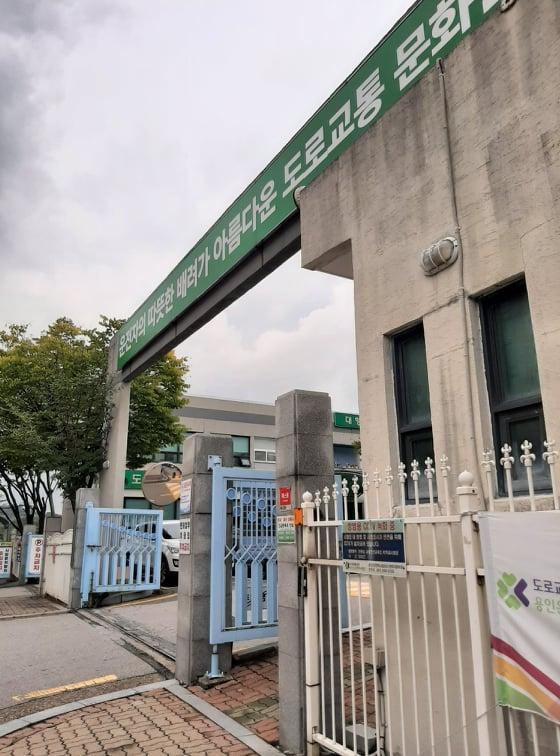
For my region, Yongin is the closest public driving center you can get your license at without aid from a hagwon. Your testing facility will depend on your location. You can ask 1330 for the address of the Driver’s License Test Center (운전면허시험잔) near you.

Yongin License Testing Center
1577-1120
Copy and paste phone numbers into Naver Maps to get directions
Description:
The center for taking driving exams, renewing drivers’ licenses, updating drivers’ license, etc.
Hangul Address:
경기 용인시 기흥구 용구대로 2267
Hangul Name:
용인운전면허시험장
Cost for Getting a License without Road School
Overall, to get my license cost just over 120,000 won-140,000 won. This included the cost of taking the exam multiple times. This did not take into consideration incidental costs such as transportation, missed days of work, etc.
Estimated Time to get a Driver’s License from Scratch
The process of getting my South Korean driver’s license took about 3 months with appointments. In the past, I’ve seen posts saying you can get this done in a day or a week but with current Covid 19 restrictions as well as having a full-time job I didn’t find this possible.
It may take you many visits and the amount of time may vary by person. If you are pressed for time, a driving hagwon may be worth the money. If you don’t do the hagwon route you need to stay flexible and allow a lot of grace for failing tests due to differences in language and culture.
Yongin Offers English Language Support and Testing
In the Yongin Driving center, there is a help desk on the side, usually, there is someone on
staff who speaks English to assist. All tests and forms were available in English. Remember that Korea provides each administrative district a great deal of self-governance. This means that each driving test center may have more or less languages and support in such languages available.
My Personal Driver’s License Story
Here’s my experience and the steps I took to acquire my Korean driver’s license! Since the South Korean government provides a great deal of flexibility for local government agencies, each driving center may have systems with differ from the one in Yongin. Always check your local testing center.
We can’t state the importance of being aware that local governments have different systems across South Korea. Much of what your read may lead you to believe that Korea has a system of universal governance, but it does not. Each administrative district has the flexibility to adapt (or not adapt) to the needs of the immediate area. Such variance greatly impacts those of us who live in rural areas.
This blog posts my experience in Yongin at a particular point in time. Expect your experience to be different based on location and changes in Korean rules over time. Allowing space for such fluidity and diversity of experience will help you emotionally navigate getting your driver’s license on your own.
Step 1: Education Course (free)

Usually, you have to sign up for the Education Course before you arrive to take the class. They say you can sign up online but I don’t think the “foreigner” option is fleshed out and did not work for me. Don’t panic, you have options. You can get someone to help you make a reservation on the Korean version of the site or you can go to the nearest testing center in person.
For this step, I visited the Driver’s License Test Center (운전면허시험잔) in Yongin to ask questions about how to sign up for my Education Course. While there, the Help Desk staff told me I could join the next Education Course Video if there was an open spot. It was my lucky day and I was able to signup for a course immediately.
The course is about an hour and it was a three-step process. First, you fill out a small form with your information to prove you have taken this course. Second, you go and sit for an “ education video” about the safety of driving. Third, you can go back downstairs take a number and sign up for the written test.
Step 2: Written Exam (7,500 won) 70% pass
I recommend studying for this test beforehand regardless of driving experience. There is an app called 운전면허. Plus, the app is a study guide and practice test with word-for-word questions you will see.
Some of the situations and questions on this test are so specific that without remembering them from the app I wouldn’t have passed. Please study this a few times before taking the written Korean driver’s license test as it will greatly reduce your frustration and likelihood of taking the exam twice.
Items Needed for the Written Korean Driver’s License Test
- Written driver’s license form (At the Yongin testing location this form is on the first floor before you go upstairs for testing)
- 3 colored ID photos with you. (If you don’t have photos there is a photo booth downstairs you can get taken for 10,000. This is also on the first floor.)
- Eye exam and ‘medical check’ (These are all taken care of in the same area as the ID photos)
After getting your form and photos, head upstairs is the testing room (remember that this is specific to Yongin). When your name appears you will go into the testing room. Turn off your phone and sit at your assigned computer. You have an hour to take the test and it’s a 70% pass rate. That means you need to pass the test with a 70% score.
Studying via the 운전면허 app I was able to pass on the Written Test on the first try.
Resources for studying for the written Korean driver’s license test:
- English information regarding the Korean written driver’s license exam.
- Study app for the Korean written driver’s license test (you change change the language to English in settings)
Step 3: “In Course” Driving Test (fee: 18,500) 80% pass
I failed the In Course Driving Test on my first try even after studying for this test for 2 weeks by watching the videos. ***This is NOT a test for your driving skills, this is a test to see if you memorized the video for the test. It is IMPOSSIBLE to do this test without studying videos. At hagwons, they are expected to memorize this with the very specific steps needed to not lose points.****
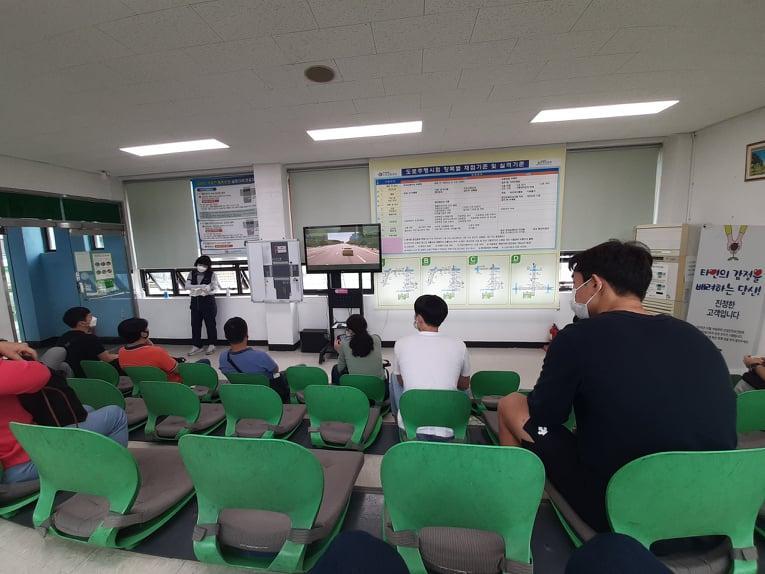
This test is a computerized driving test in course. It has a small computer screen in the
car and you drive solo around this course. The purpose of the In Course Driving Test is to show that you understand how to use the blinkers, wipers turn on the car, etc. And driving skills like: stopping on a hill, 3
point turn/parking, speed control zone (aka can you speed up and slow down according to
signs). Points are automatically deducted and announced to you when do not do exactly as the video recommended.
The screen and voice commands are available in English. However, the staff will need to choose the English setting. Please tell the staff beforehand to make sure that you have the right language option for you.
On paper, this test isn’t difficult. The test only covers the most basic skills, however, the key is learning what small things count as a minus point. PLEASE study the linked videos. This test is monitored by GPS and totally computerized so is VERY SENSITIVE and ruthless.
Hurdles for Taking the “In Course” Driving Test
Here is a quick list of the issues I had while taking this test.
Hurdle 1: Small Points Count
Many points can be taken off before you even start the car. You will hear a set of beeps after she says the command and only then complete the task in 5 seconds. Then you will hear a little chime showing you completed it. Easy ways to lose points such as: if you fail to turn the blinkers off 5 seconds after
the command…..-5pts . If you complete the task said before she finishes the sentence and pauses….-5pts.
This is a driving hagwons video and it was very very useful. I recommend taking notes for the beeps. This is all in Korean but the format is exactly the same.
Another example video of the course but just for an idea of what it looks like outside the car.
When you begin the test after turning on the car turn on the left signal light to tell the computer you are starting. THEN turn it off in 5 seconds or points are deducted. (small note…in my test, she said “ turn on the upper lights….then…..turn off the lights” I was confused as I call these high beams….you can also not pause between turning up to high beams and back down when you turn them off she will count it as a fail.)
Hurdle 2: “T-parking”
Important: You must complete ‘T-parking’ in 1 minute or it is an automatic fail.
DO NOT DO THIS AS YOU WOULD DRIVE NORMALLY. I did and almost took too long
lining up the doors. Hagwons teach ‘T-parking’ a specific way by lining up mirrors and turning the wheel. Using the trick to line up the mirror with to the parking lines helped.
A final tip for this one, you need to pull the emergency brake. I did not find this mentioned in English. When you back up the car and pass the white line, automatically pull up the emergency brake until you hear a chime. Then you may start to exit the T-parking zone.
Resources for studying for the T-parking:
Hurdle 3: Express way zone
This portion isn’t difficult, just make sure you maintain over 20km about 5 meters AFTER
you pass the sign.. then slow back down within 5 meters AFTER you pass the next slow
down sign. ( I failed at the end because I slowed down before the sign.)
After you do the simulated ‘expressway’, turn on your RIGHT blinker to let the test know you’re
done. Then it will announce if you passed or failed.
The Next Step
- If you pass: Pick up your stamped form and sign up for the road test. In Korea, you will have to choose betwen an automatic license and a stick-shift license.
- If you fail: Schedule another appointment to take the “In Course’ driving test again. It is quite common to fail the “In Course” test.
Step 4: Road Test (Fee: 25,000 won) 80% pass
The ‘Road Test’ is the final part of the Korean Driver’s License exam process. This is when you get out on the road with a proctor in a car provided by the testing center. You do not take the driving exam in your own vehicle. The testing vehicle has been rigged with computers which help with the testing.
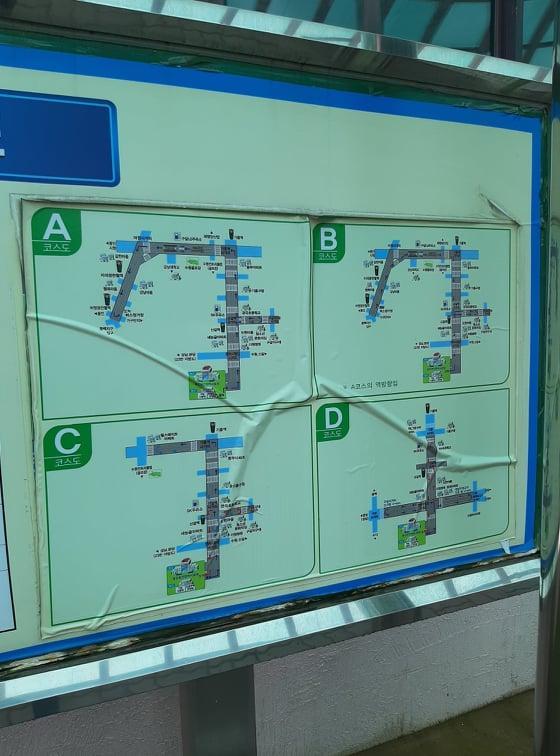
This test might be taken alone or with another test-taker in the car. One of you will take the test on the drive away from the testing center and then you change seats and the other person will take the test on the way back to the testing center.
Hurdles for Taking the Road Test
The Road Test might be one of the easiest parts of getting your driving license in Korea if you have been driving for a while. However, there are some key points that could cause you to fail. Here are a few tips I learned.
Road Test Hurdle 1: Language Barrier
I recommend if you speak Korean, please ask them to ONLY use Korean for instruction. I failed the Korean Road Test the first time due to “helpful English” from the instructor. Due to a
misunderstanding, I had an automatic fail on a U-turn mistake. Be prepared for such miscommunication but don’t let it hold you back.
If you don’t speak Korea, I recommend looking at all the routes so that you know what route you will be driving and can prepare for the instructor’s prompts. I also recommend fully studying how U-turns happen so that you can rely fully on your knowledge rather than decoding the language differences.
Road Test Hurdle 2: U-Turns
But for me coming from a state where U-turns are illegal, knowing the U-turn rules in
Korea is important. For example: in Korea, you do not cross the line to do the U-turn, it must
be done within the provided U-turn lane. Additionally, U-turns can not be done on red. Don’t miss this detail when getting your driving license in Korea
Road Test Hurdle 3: Over Do Everything
ALWAYS keep your hands at 10 and 2. Exaggerate looking for all the vehicles. Do not seem relaxed or overly confident. Give them a big show that says, “I know exactly what I need to be doing here.” We have known people who lost points simply for being casual.
Click here to preview the Yongin Road Test maps. Always look at the maps before taking the test.
Official Driving Youtube page: This has the same intro videos they show there and other locations driving course videos.
Overall, the driving part is pretty straightforward. If you have experience driving this test is not
difficult to pass on the first try with a bit of studying and looking up special rules.
Road Test Hurdle 4: Lane Changes
The only other special case you need to look out for is signaling a lane change. You must
signal at least 30 meters before your lane change. (30meters about 5 dotted lines on the
road..I signaled..counted then merged).
Resources for Preparing for your Road Test
The Next Step
- If you pass: If you get over 80 points you pass! They will give you your license on the first floor.
- If you fail: Schedule another appointment to take the Road Test again.
Everyone’s Experience May Be Different
There are many moving parts involved with doing the testing on your own. As mentioned before, we each bring our own experiences and conceptual understandings of processes and language. This blog can’t guarantee you won’t struggle in areas that I found easy or easy pass the part of the testing that I found difficult. Allow grace for yourself and the process.
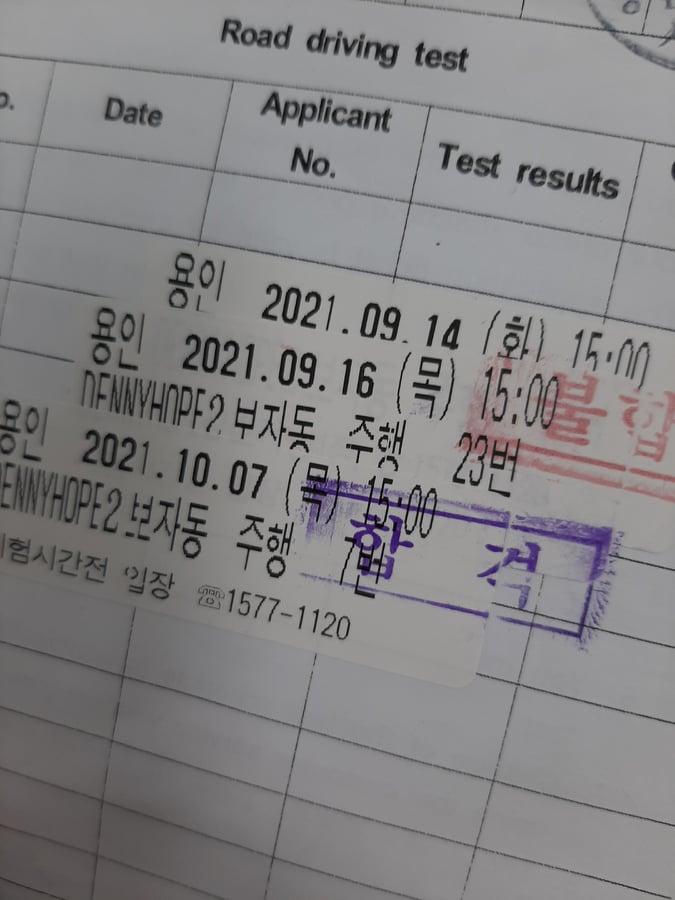
International Driver’s License Version
For an extra 5,000 won, you can also get the “International version” which has your information in English on the backside. You want to do this so that you can easily use your Korean Driver’s License when you travel outside the country.

Hope Denny holds a Master’s in Education with a focus on ESL and a Bachelor’s in International Studies. She also received a Certificate in Korean Studies from Ewah Women’s University. Hope Denny works in the Korean public school system.
Content Disclosure: South of Seoul blogs are written by unpaid volunteers.



